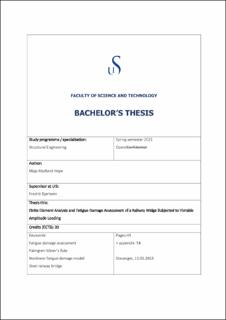| dc.contributor.advisor | Bjørheim, Fredrik | |
| dc.contributor.author | Hope, Maja Mydland | |
| dc.date.accessioned | 2023-06-30T15:51:27Z | |
| dc.date.available | 2023-06-30T15:51:27Z | |
| dc.date.issued | 2023 | |
| dc.identifier | no.uis:inspera:135917059:35691684 | |
| dc.identifier.uri | https://hdl.handle.net/11250/3074759 | |
| dc.description.abstract | Many of the railway bridges in Norway and the rest of the world are closing in on the end of their predicted service life, and the need for more precise fatigue life assessments and predictions is challenging for the railway authorities. Fatigue is a phenomenon that to this day is a mysterious and complicated process. At the time when many of the oldest bridges were built, fatigue was not particularly considered in design. Fatigue is one of the main reasons for failure in steel structures, and the consequences can potentially be fatal since a fracture is a quick process and without significant visible signs. The Palmgren-Miner’s rule, which is the standard method used for fatigue assessments on older railway bridges, have been found to be imprecise, as it fails to properly account for the variable amplitude loading. The rule considers damage to be linear, while research has shown that the process is in fact highly non-linear.
This thesis performs a fatigue life assessment for an actual ageing steel railway bridge based on provided data of loading history. The conventional Miner’s rule and one other proposed nonlinear model is utilized to estimate the damage and remaining fatigue life of Saulidelva Bridge on Bergensbanen, Norway. This thesis aims to compare and analyse the results obtained from the two fatigue assessment methods, shedding light on the discrepancies resulting from simplifications in modelling, the choice of partial safety factors and S-N curves, and most important, the incorporation of variable amplitude loading. | |
| dc.description.abstract | Many of the railway bridges in Norway and the rest of the world are closing in on the end of their predicted service life, and the need for more precise fatigue life assessments and predictions is challenging for the railway authorities. Fatigue is a phenomenon that to this day is a mysterious and complicated process. At the time when many of the oldest bridges were built, fatigue was not particularly considered in design. Fatigue is one of the main reasons for failure in steel structures, and the consequences can potentially be fatal since a fracture is a quick process and without significant visible signs. The Palmgren-Miner’s rule, which is the standard method used for fatigue assessments on older railway bridges, have been found to be imprecise, as it fails to properly account for the variable amplitude loading. The rule considers damage to be linear, while research has shown that the process is in fact highly non-linear.
This thesis performs a fatigue life assessment for an actual ageing steel railway bridge based on provided data of loading history. The conventional Miner’s rule and one other proposed nonlinear model is utilized to estimate the damage and remaining fatigue life of Saulidelva Bridge on Bergensbanen, Norway. This thesis aims to compare and analyse the results obtained from the two fatigue assessment methods, shedding light on the discrepancies resulting from simplifications in modelling, the choice of partial safety factors and S-N curves, and most important, the incorporation of variable amplitude loading. | |
| dc.language | eng | |
| dc.publisher | uis | |
| dc.title | Finite Element Analysis and Fatigue Damage Assessment of a Railway Bridge Subjected to Variable Amplitude Loading | |
| dc.type | Bachelor thesis | |
